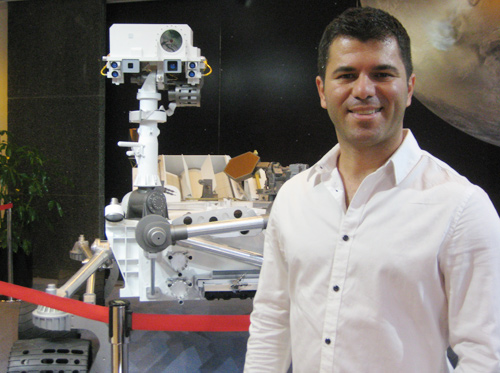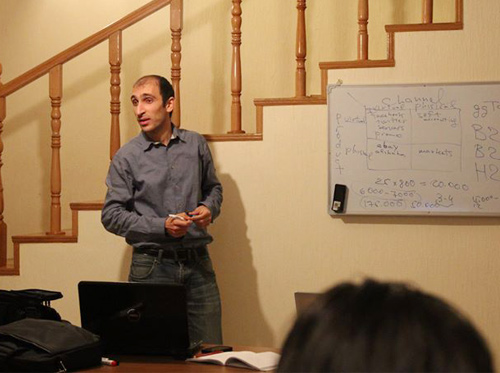-

Richard Ohanian
10:11 | 16.07.15 | Interviews | exclusive 13894
Richard Ohanian: Armenia has potential for space industry
Engineer at NASA Jet Propulsion Laboratory (JPL) Richard Ohanian who joined JPL's Communication, Tracking and Radar Section in 2010 was in Yerevan a few days ago.
Richard Ohanian has been involved in various space flight projects, including Mars Science Laboratory (Curiosity Rover), Mercury Ion Deep Space Atomic Clock, FINDER and Deep Space Optical Communication.
Richard Ohanian also teaches Electronics and Robotics courses at Glendale Community College as adjunct faculty.
Itel.am had an exclusive interview with Richard Ohanian in Yerevan.
-Could you talk about JPL’s activities and the contribution of Armenians in the center?
-Basically, The U.S. Space Program started at Jet Propulsion Laboratory, which is a division of California Institute of Technology. In 1958, Explorer 1, United States first satellite, was designed and built by JPL engineers and scientists.
JPL is the only place in the world where very complex space robots are designed and built, the latest one among them, the Curiosity Rover, grabbed world’s attention after its successful and dramatic landing on Mars in summer 2012.
Currently, JPL is the number one place in the world, where robots and satellites are designed and built for “deep space” exploration (for example, Voyager1 & 2, Viking 1& 2, etc.). The entire process from idea generation to mission definition, R&D, design, implementation and test is performed at JPL for these robots and satellites.
The center has around 5000 employees. It is a short drive from Glendale and Pasadena cities, where are home to a large Armenian community, and for that very reason, some 150 Armenian Americans work at JPL as scientists, engineers and supporting staff.
What makes JPL unique is the organizational memory accumulated at this place, with some 50-60 years of history. For example, the Curiosity Rover, which landed on Mars, was developed within four-five years but prior to that JPL had designed, built and launched three other rovers, which were successfully deployed on Mars. As a result of numerous past experiences, JPL can manage implementation of new complex projects in a relatively short time, and more efficiently and effectively.
-Space industry is a costly enterprise. How can small countries engage in the development of this sector?
-As far as I know, Armenia does almost nothing in that sector; therefore, Armenia can take initial steps and start a space industry.
Yes, space industry is very expensive and building a spacecraft requires a long time, interdisciplinary expertise and knowledge as well as lots of money. Perhaps as an initial project Armenian engineers and scientists can design and build a CubeSats.
CubeSats are small satellites, imagine small boxes, that perform a few functions in space. Unlike big spacecrafts, Cubesats take relatively lesser time and budget to design and integrate. Local universities can set up small teams of faculty and students and start the process.
For example, there are numerous universities in the U.S., where student teams design and build cubesats and get help from NASA to deploy them to space on NASA rockets.
-How long does it take to develop a Cubesat?
-In general, it can take one to three years. It might take longer if there is lack of expertise and experience. However, that should not be a problem; one should start, and commit tirelessly one’s efforts. Space business is hard, so failures are inevitable; one might fail five times only to succeed the sixth time.
I believe creation of a research and development center for space technology in Armenia bares a strategic value for the country, and CubeSats might serve as the initial projects for such a center.
-How much will it cost to develop a CubeSat?
-Depending on the complexity of the project, the cost could vary from USD 100 thousands to several million dollars. But that is very cheap considering that a traditional spacecraft could cost more than couple of hundred million dollars from design to implementation and launch.
-Where should we seek investors?
-I believe the space program of every country should be somewhat state-funded. At least in Armenia, the government should back up such efforts since it has all the resources to fund and jumpstart such an industry.
-Let’s suppose the CubeSat developed in Armenia is ready and is sent into space. How will Armenia benefit from it?
-Technology, practice and prestige; science and technology developed for space industry can be used in other sectors and industries as well. I believe Armenia has the necessary human capital, potential and financial resources to develop a CubeSat program. However, a strategic plan is needed to develop a long term road map and then the engineers and scientists should get to work.
-Is Armenia interested in it?
-I had several meetings at a number of universities. I am trying to understand the level of knowledge and expertise in Armenia, however, my time was very limited and I didn’t get to see the whole picture to form a comprehensive idea. Perhaps not many are interested in the abovementioned ideas at the moment. Perhaps Armenia is not ready to develop such complex projects that require interdisciplinary and system-level thinking and approach – from idea to implementation. But that doesn’t we should not try.
Many of us hope to see experts in Armenia develop more complex, interdisciplinary, and system-level technologies, from system design to implementation, and improve them in time.
-Transfer of foreign practice is important, isn’t it?
-The Diaspora can certainly have its input in Armenia’s scientific, industrial and technological development. Diaspora experts can share their best practices and experiences, even via personal contacts.
But experts in Armenia should initiate that process and take steps in establishing such contacts. However, there are nuances to consider. For example, Diaspora experts might have limitations in technology transfer or cooperating with their counterparts in Armenia. For example, many Armenian engineers, who are employed at companies all over the world, have no right to speak about the technologies they develop as those will be their companies’ products, hence confidential. There are various intellectual property rights and issues to honor as well.
Having said that, there is a huge amount of public information and knowledge out there that is available to everyone. There are various scientific journals and publications, which can be useful as well and experts in Armenia can use them to develop new technologies.
Continuity is essential for developing a space industry, but initially, somebody in the country just needs to start it. The process will take time, but the return on investment is significant. For example, India launched its space program some 40 years ago and Indians have made great progress, and they even deployed a satellite towards Mars. It cost them roughly USD 80 million, which is very low cost for such a mission.
Establishing a local and native space industry has strategic importance for the country and technologies developed in space programs can be used in other sectors and industries. For example, there are already Armenian tablets, and the technology developed to build the tablets can be used in other sectors and areas.
I believe education is overly important for tomorrow’s technological and scientific advancements. Education should be further enhanced in Armenia; more hands-on, interdisciplinary and applied methodologies and approaches should be integrated in the Armenia’s educational system. There is a movement to create new schools and educational systems in the country; however that is targeting a small population, perhaps just 10% of the students. New educational models and methodologies, such as action/active learning, should be applied in all schools and universities and everyone should have access to such a modern educational system, not just the top 10%.
Innovation and creativity should be further encouraged in Armenia’s educational system. Hands-on practices to learn from trial and error in laboratories should be integrated in schools and universities. Perhaps the entire educational system and style should be reviewed and as a result modernized.
I emphasize the need to further promote the spirit of innovation and creativity in schools and universities. An option can be establishing maker/hacker-spaces at schools for children sharing such interests to come together, do joint projects and learn by doing and from each other.
Narine Daneghyan talked to Richard Ohanian

17:29 | 24.09.25 | Articles
Jacopo Losso on Cross-Border Investments and Why Armenia Attracts Angels








